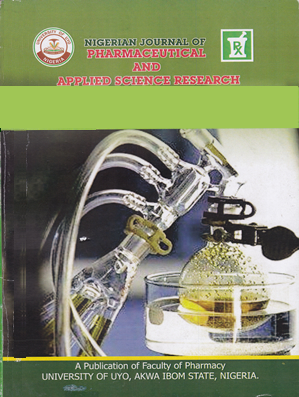Albizia zygia (D.C.) Macbr (Fabaceae): A Comparative Investigation of Phytochemical Composition, Proximate Analysis and Anti- Seizure Properties of Methanol Extracts of Its Leaves and Stem-Bark.
Contenu principal de l'article
Résumé
Albizia zygia belongs to the legume subfamily Mimosoideae. Albizia lebbecka, a congener of Albizia zygia is reported to possess anti-seizure activity and folk reports of sedation when the leaves of Albizia zygia are consumed. This aim of this study was to compare the phytochemistry, proximate parameters and possible anti-seizure properties of the methanol extracts of the leaves and stem-bark of Albizia zygia. Phytochemical screening and proximate analysis were carried out according to standard methods. Pentylentetrazol (PTZ) and maximum electroshock (MES) test were employed to investigate the anti-seizure properties in mice at 200, 400 and 800 mg/kg doses. Both samples had saponins and flavonoids in common but phenols were only present in the leaves while alkaloids, tannins and proteins were found only in the stem-bark. Anti-seizure activity of the stem-bark was superior to that of the leaves and was significant (p<0.05) in the PTZ test. This study lends support to the ethnomedicinal use of the plant in the management of seizures.
Téléchargements
Renseignements sur l'article

Cette œuvre est sous licence Creative Commons Attribution - Pas d'Utilisation Commerciale - Pas de Modification 4.0 International.
Références
Achakzai A.K, Achakzai P, Masood A, KayanI S.A, Tareen R.B (2009). Response of plant parts and age on the distribution of secondary metabolites on plants found in Quetta. Pakistan Journal of Botany, 41: 2129-2135.
Abere T.A, Ibanishuka P, Jesuorobo R.I. (2014). Analgesic and toxicological evaluation of the stem bark of Albizia zygia Benth (Mimosoideae). IOSR Journal of Pharmacy and Biological Sciences (IOSR-JPBS). Vol 9(2) IV, 26-31.
African Pharmacopoeia (1986). Vol. 2 1st ed., OAU/STRC publications: pp 128-144.
Aliyu A.B, Musa A.M., Ibrahim, M.A., Ibrahim H. and Oyewale A.O. (2009). Preliminary Phytochemical screening and Antioxidant activity of leave extract of Albizia chevalieri. Bayero Journal of Pure and Applied Sciences. 2 (1), 149-153.
Burkill, H.M. (1995). The useful plants of West Tropical Africa.2nd ed. Families J–L. Royal Botanic Gardens, Kew, Richmond, United Kingdom.3:857
Evans W.C. (2005). Trease and Evans Pharmacognosy, London, Fifteenth Edition, Elsevier, 137-149.
Jung M.J., Kang S.S., Jung Y.J., Choi J.S. (2004), Phenolic Glycosides from the Stem Bark of Albizia julibrissin. Chemical and Pharmaceutical Bulletin. 52: 1501-1503.
Kang T.H., Jeong S.J., Kim NY, Higuchi R, Kim Y.C. (2007). Sedative activity of two flavonol glycosides isolated from the flowers of Albizzia julibrissin, Journal of Ethnopharmacology.71: 321–323.
Karuppannan k. Phytopharmacological properties of albizia species: A review. International Journal of Pharmacy and Pharmaceutical Sciences. 10 Aug 2013. Vol 5, Suppl 3.p 1.
Kasture V.S, Kasture S.B, Pal S.C (1996): Anti-convulsant activity of Albizia lebbeck leaves. Indian Journal of Experimental Biology. 34(1) 78-80.
Khatoon M, Islam E, Islam R, Rahman A.A, Alam A.H, Khondkar P, Rashid M, Parvin S (2013), Estimation of total phenol and in vitro antioxidant activity of Albizia procera leaves. Biomedical central Resources Notes 6: 121-123.
Lau C.S, Carrier D.J, Beitle R.R, Bransby D.I, Howard L.R, Lay J.J, Liyanage R, Clausen E.C. (2007), Identification and quantification of glycoside flavonoids in the energy crop Albizia julibrissin. Bioresources and Technology. 98: 429-435.
Margret R, Chandira G, Jaykar B. (2013): Extraction, Pharmacological Evaluation and Formulation of Selected Medicinal Herbs for Antidiabetic Activity. International Journal of Pharmacy Teaching & Practices. 4:458-482.
Mbang N. F, Musiliu O. A, Taiwo O. (2014): Evaluation of the Suspending properties of Albizia zygia on Sulphadimidine suspension. Tropical Journal of Pharmaceutical Research. 279 -284.
Melek F.R., Miyase T, Ghaly N.S., Nabil M. (2007): Triterpenoid saponins with N-acetyl sugar from the bark of Albizia procera. Phytochemistry. 68: 1261–1266.
Miyase T, Melek F.R., Ghaly N.S., Warashina T, El-Kady M, Nabil M. (2010): Echinocystic acid 3, 16-O-bisglycosides from Albizia procera. Phytochemistry. 71(11-12): 375-80.
Muna A; Abdalla M; Hartmut L. (2012): Flavonoids from Sudanese Albizia zygia (leguminosae, subfamily mimosoideae), a plant with antimalarial potency. African Journal of Traditional Complement Alternative Medicine. 9(1): 56-58.
Ndjakou B. Vonthron S, Fongang S, Tantangmo F, Ngouela S, Kaiser M, Tsamo E, Anton R, Weniger B (2007): In vitro antiprotozoal activities and cytotoxicity of some selected Cameroonian medicinal plant. Journal of Ethnopharmacology. 111:8-12.
Odeyemi O, Oluduro A.O, David O.M (2014): Evaluation of Antimicrobial Activities of Albizia zygia DC leaf extracts against some clinically important pathogens. Journal of Natural Sciences Research. 4(9): 98-105.
Orwa C. A Mutua, Kindt R, Jamnadass; Anthony R.S. (2009): Agro forest tree Database: a tree reference and selection guide version 4.0 (http://www.worldagroforestry.org/sites/treedbs/treedatabases.asp). Accessed 23/08/2016.
Sabrina K, Odile T, Thierry S, Richard W, Catherine L (2005). Triterpenoid saponin anthranilates from Albizi agrandibracteata leaves ingested by primates in Uganda. Journal of Natural Products. 68: 897–903.
Sarkiyayi S, Karago J, Hassan R (2011): Studies on Anti Typhoid Properties of Aqueous Methanol Leaves Extract of Albizia ferruginea. International Journal of Biochemistry Research & Review. 1(1): 24-30, 2011.
Sartaj B.M, Helen D.A, Ramesh C (2012): Evaluation of anti-hyperlipidemic and Antioxidant activity of Albizia Amara. International Journal of Biological and Pharmaceutical Research. 3(7): 875-882
Siju E.N., Anusha K.V., Fairuza M.K., Kuttoor D.S. Minil M, Rajalakshmi G.R. (2014): In vitro study of anti-inflammatory activity of Albizia julibrissin. International Journal of Research in Pharmacy and Science. 4(2):24 – 26.
Sivakumar B, Velmurugan C, Logesh P (2013): Diuretic Activity of Methanolic Extract Of Albizia lebbeck. International Journal of Pharaceutical Technology Research. 5:404-406
Sofowora, A. (1993): Medicinal plants and traditional Medicine in Africa, 2nd edition. Spectrum Books Publisher. Ibadan, Nigeria: 134-136.
Steinrut L, Itharat A, Ruangnoo S (2011): Free radical scavenging and lipid peroxidation of Thai medicinal plants used for diabetic treatment. Journal of Medical Association of Thailand 7:178-82.
Zheng L, Zheng J, Zhao Y, Wang B, Lijun W, Liang H (2006): Three anti-tumor saponins from Albizi ajulibrissin. Bioorganic and Medicinal Chemistry Letters. 16: 2765–2768.
Zou, K, ZhaoY.Y., Zhang R.Y (2006): A cytotoxic saponin from Albizia julibrissin. Chemistry and Pharmaceutical Bulletin (Tokyo). 54(8): 1211-2.


